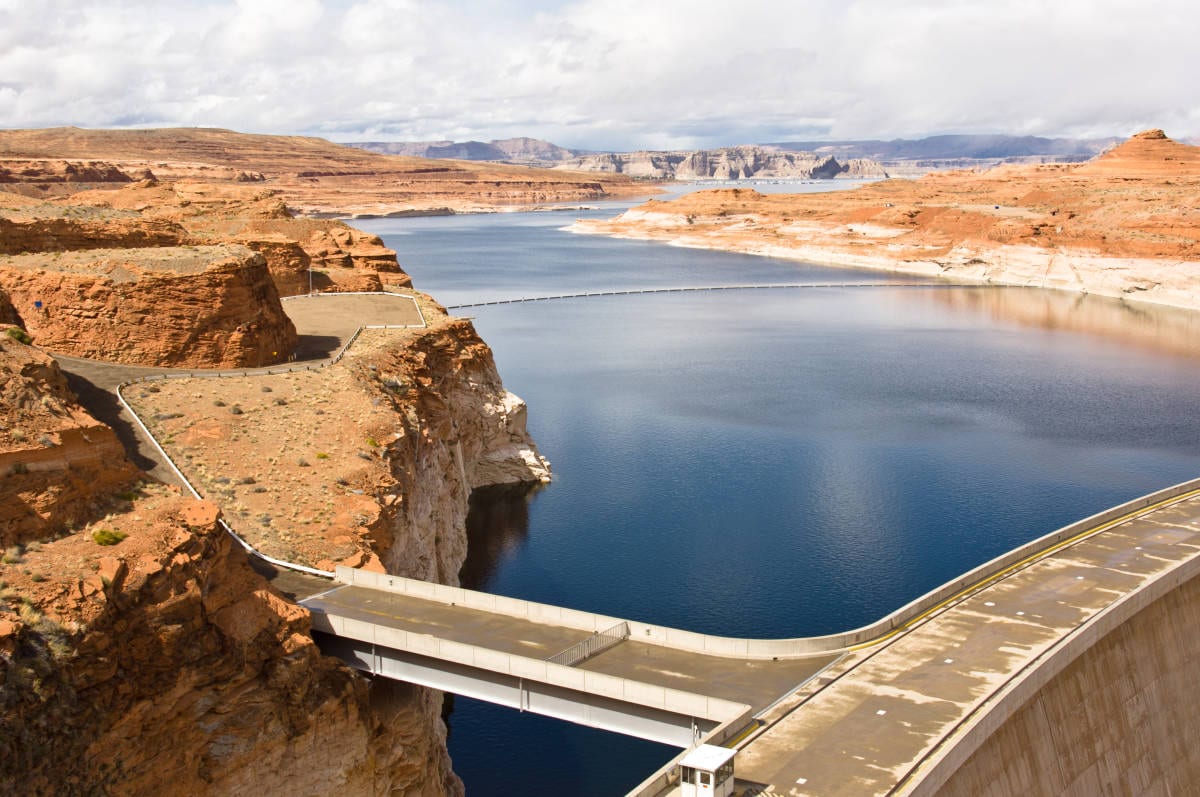
This is third part in a series examining the issue of the Lake Powell Pipeline. See links to the first two articles at the end of this one.
Like many of the issues relating to the predicted growth of Washington County, the Lake Powell Pipeline is a complex issue with no easy answers. The superlative weather, scenic beauty and lifestyle opportunities will continue to be a big draw for prospective future citizens, and water is an issue that must be addressed.
In this week’s installment on the Lake Powell Pipeline, The Independent will examine the the two main arguments made by the proponents of the pipeline: Washington County Commissioner Alan Gardner, Utah Division of Water Resources Information Officer Joshua Palmer, and Washington County Water Conservancy District General Manager Ron Thompson.
Argument #1: There is not enough water in the county to satisfy the needs of a growing population.
There is little debate that St. George, Washington County and the municipalities of Washington County are growing at a rate that is one of the fastest in the nation. Utilizing the figures provided by the Washington County Water Conservancy District (30,000 acre feet per year) it would seem that the county will need a new source for water. Lisa Rutherford, former board member of Citizens for Dixie’s Future, says that the county is using misleading figures when stating the water totals available for the county. She points to a 2011 Special Summer Edition of the Conservancy District’s publication Water Line (TM.)
In that publication, it states, “Without the 69,000 AF [Acre Feet] from the Lake Powell Pipeline Project, only 105,000 AF of water could be developed. This would supply Washington County with sufficient water until sometime in the early 2020’s and would serve a population of approximately 280,000 residents.”
They have a bias against water conservation. They just really want to sell water and build this big project and not look at other alternatives. You could really conserve and still have enough water for everyone. – Jane Whalen
Rutherford says that the number of residents stated in the publication—280,000—is also misleading, because the Water District is using figures that are far above the standard use of gallons per capita per day, along the lines of 335 GPCD. Using the figures the Washington County Conservancy District states for daily usage, 144 GPCD—which is only for residential usage, not a total for usage for the county—the 335 is allowing for nearly 200 more gallons per day. Rutherford states that if the county was able to reduce total water usage to 144 GPCD—which is comparable to the total daily water usage in Albuquerque, New Mexico—then the 105,000 acre feet would support a population of close to 600,000. Rutherford says that using Albuquerque as a comparison benchmark is useful because the city of over 500,000 people in a desert environment uses a similar amount of anticipated water per year (100,000 acre feet).
“People read this and they go, ‘oh, well we need water.’ Well, not if we’re using 335 gallons per capita per day,” Rutherford said.
Zach Frankel, the executive director of the Utah Rivers Council, says that the figures used by the water district are scare tactics and that there is more than enough water available to satisfy the growth demands of Washington County.
“Most of the time, what we see in the growth discussion is a fallacy to scare people into believing we need these water projects,” Frankel said. “The reality of the situation is that St. George, Washington County and the rest of Utah have tons of water for all forecasted growth. Anyone who counters otherwise is selling propaganda.”
Frankel also says that the District cherry-picks their numbers depending on who they are giving those figures to.
“We come to them and say ‘Look, water use in Washington County is too high. It’s 328 [gpcd] or its 294,’ and they say, ‘Oh no, our water use, why it’s 144, it’s 108.’ But when they go to forecast the need for the project, the future population growth times the per person water use, suddenly their water use climbs,” Frankel said. “What they’re doing is, when faced with criticism for wasting too much water, they say, ‘We’re not using too much water,’ but then they pull out another set of numbers when they’re trying to scare people into believing they’re running out of water.”
Frankel points to an audit conducted by the Office of the Legislative Auditor General from May of 2015. In this report, the audit criticized the manner in which the Utah Division of Water Resources utilizes local water reports for their figures. It states, “The Division of Water Resources relies on water use data submitted by local water systems to the Division of Water Rights as the starting point for projecting future water needs. Unfortunately, we found that the submitted data contains significant inaccuracies. State water agencies as well as local water systems operators also acknowledge these inaccuracies.”
Jane Whalen, board member of Citizens For Dixie’s future, agreed that there was more than enough water within the county to satisfy future growth needs. She states that inaccurate water figures make it more difficult to gauge what the county uses and needs.
“We just need to become more efficient in our water use,” Whalen said. “The first thing we need to do is to get some accurate data, which we don’t have on use and water supplies. Every time a report comes out, it’s always different. Everybody says different things. It’s just really hard to figure it out.”
Whalen also says she believes that water conservation is a key to ensuring the county has enough water for the present and future, but the proponents of the pipeline are only paying lip service to conservation.
“They have a bias against water conservation,” she said. “They just really want to sell water and build this big project and not look at other alternatives. You could really conserve and still have enough water for everyone.”
Whalen also pointed out an article in Businesswire that shows that Fitch Ratings (one of three ratings organizations designated by the United States Securities and Exchange Commission) claiming the county has significant water supplies.
According to the article, “Over 40% of the district’s 42,110 af [acre feet] per year of water sources is surplus and will be used to serve future growth. The district’s peak summer demand is 37 million gallons per day (mgd) and winter demand is 7 mgd compared with current capacity of 48 mgd. Furthermore, the district plans to expand capacity to 60 mgd in about a year. The district is operating a groundwater recharge program that currently provides 100,000 af of water and will ultimately provide access to up to 300,000 af.”
Argument #2: The pipeline is a less expensive way to import water.
When it comes to the debate over whether the pipeline is a cheaper source of water, Frankel reiterated his analogy from the first article in this series: “Anybody that thinks the glass of water 150 miles away from them is cheaper than the glass of water in front of them on the table needs to have their head examined.”
Twenty-one Ph.D. economists asked this question [about the costs] and found that water rates will have to go up at least 500 percent to repay the Lake Powell Pipeline. They could go up as much as 2000 percent. – Zach Frankel
“If they wanted to say this is the most expensive water source but we should do it anyway, that’s an honest thing to say. Any elected official who stands up and says, ‘The Lake Powell Pipeline is the cheapest source of water’ is totally out of touch with their constituents desires.”
Frankel pointed to the recent report by multiple Utah economists who criticized the Lake Powell Pipeline as being too expensive and risky as another reason to have doubts about the costs.
In interviews with the Independent, Frankel, Rutherford and Whalen all claim that the details of the repayment plan have been kept secret. The say that Thompson claims the plan is ‘propitiatory’ and will not release the information.
“Twenty-one Ph.D. economists asked this question [about the costs] and found that water rates will have to go up at least 500 percent to repay the Lake Powell Pipeline. They could go up as much as 2000 percent. In response, Ron Thompson claims there is a secret repayment model out there demonstrating that the pipeline costs can be repaid with interest with only a few pennies increase in rates. He will not share that repayment model.”
Frankel said that by withholding this repayment plan, it is akin to someone purchasing a car, getting approval but then being told that the buyer cannot view the terms of the loan.
“That car buyer should run out of the dealership as fast as possible,” Frankel said.
Rutherford also feels the costs of the Lake Powell Pipeline are being understated by the Conservancy District. She pointed out that the County claims that the repayment will cost an estimated $11,000 per acre foot, but that cost does not account for either interest or an increase in expenses.
“You can’t rely on that $912,000,000 figure being what we’re going to end up paying for this project,” Rutherford said. She also pointed out that the State Division of Water Resources is currently finalizing their updated water needs assessment which will update the estimated costs for the project.
“It will be interesting to see what their new cost projection is,” she said.
Whalen states that the County is relying too heavily on deferred payments and the State of Utah to complete the costs for the project. She is also concerned that the conservancy district is not releasing the details of the repayment plan.
“Somebody has to pay for it eventually,” Whalen said. “What Ron [Thompson] is saying is there’s not a responsibility to pay for it now. He only has to pay a little bit, just what he uses. Still, there is that bulk of debt that the State has to carry. We don’t know all the costs. We know it’s going to be more than a billion dollars. Ron keeps insinuating the State is going to carry the debt, and the [water] rates are only going to go up a few cents.”
Whalen says that because the repayment plan is not being released, it makes an honest examination of the eventual costs difficult to ascertain.
“We’re saying, ‘Let’s see your plan. Can you disclose what it is and how you get there and how you do this?’ So far, after ten years, [Thompson] still hasn’t really told us.”
Next week: The proponent’s response.






Mr. Gilman, thanks for this third part in your excellent series on the Lake Powell Pipeline (LPP). It seems clear that the LPP is a high risk, unneeded, and incredibly expensive boondoggle. It was wrong for the Utah Legislature to approve a LPP funding mechanism whereby all Utah citizens “loan” the upfront billions of taxpayer dollars with Washington and Kane County water users expected to pay back the money over fifty or more years. It is also wrong that Washington County continues to use property taxes to pay the water district because this skews demand and does not correlate costs with uses. The Utah Legislature should repeal the LPP funding law, and Washington County should not use property taxes to pay the water district. These reforms are needed so that local officials will truly focus on the cheapest and most reliable source for meeting our future needs: water conservation.
It’s interesting that our water district manager, Thompson, likes to assert that nearly all legislators approved the Lake Powell Pipeline Act in 2006. Yes, Mr. Thompson, when it cost about $585 million – not the $1 billion plus (which will be much more with financing costs!). Washington County citizens – except those who will benefit directly from the project – are hoping that our legislators are finally getting the message that they’ve been sold a “bridge” that won’t get us where we want to be. In fact, all Utahn’s should be hoping this goes away since many things that need funding will be ignored due to this pipeline’s cost. There’s enough water for plenty of growth without obligating our children and grandchildren to this grand scheme that’s more of a testament of one’s ego than a necessity.
The Powell pipeline project has greatly disturbed me since I moved to southern Utah from Denver 4 years ago. The reported lack of transparency provided by the project’s proponents is troubling. Their alleged refusal to share the financing repayment plan arguably suggests subterfuge, at some level. At the very least, refusing to share financing plans and data methodology should be nonstarters for any project in the public domain. If proponents of a policy, procedure or plan, cannot or will not provide supporting information, or cannot or will not explain why that policy, procedure or plan makes sense and should be adopted and/or sustained, addressing all questions and competing concerns, then perhaps that policy should be changed or rejected. The narrative of the Powell pipeline is becoming bogged down by the weight of the detail. Perhaps that is a tactic being used by proponents. Perhaps citizens just become confused or distracted. Southern Utahns should not abdicate their right and duty to understand the issues surrounding this project; southern Utahns should not simply acquiesce to their leaders and assume that those leaders know best. That will be a shame. It’s not hard to know how much water your family uses per capita. Ask your neighbors. Are the projection numbers being used by the pipeline’s proponents reasonable? We conserved water in Colorado. The rules were strict but tolerable. They made sense. Citizens understood the stakes involved and accepted the rules as a requirement to live in Colorado. There are essentially zero rules for conservancy here in southern Utah. Why? I now live in a desert and yet my water usage is managed by a “whatever” governmental policy. It makes no sense to forego conservation and make the leap from Washington County to Lake Powell via water pipeline. To say nothing of the myriad issues surrounding the water levels in Lake Powell and the sustainability of Powell as a viable source. As I have read of the political wrangling surrounding the proposed pipeline, this project has never passed the smell test for me. I am very leery of pricey public projects which are cobbled together behind soundproof doors. I don’t like propaganda of any kind. Propaganda, by definition, is intended to manipulate minds. I prefer facts and data, and thinking critically for myself. If facts and data are not provided, or are sanitized or propagandized to manipulate minds, we should be alarmed. In my world, truth is ALWAYS useful. Always!